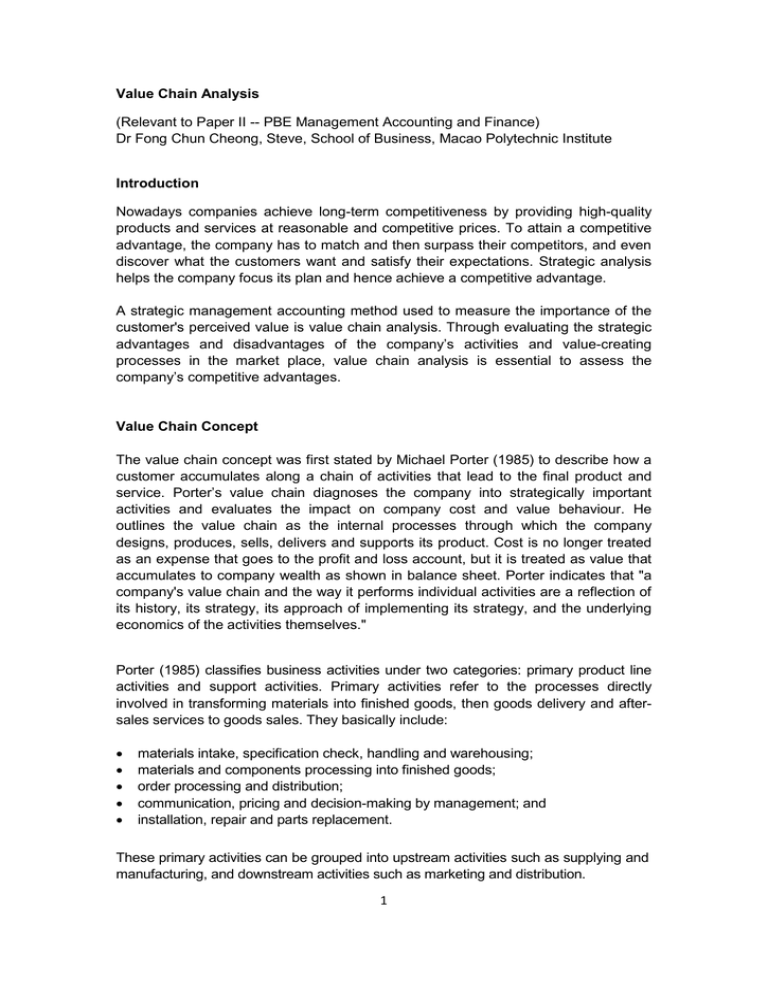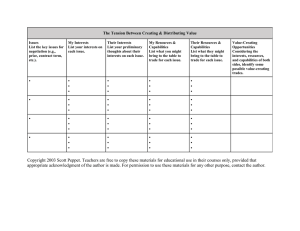
Value Chain Analysis
(Relevant to Paper II -- PBE Management Accounting and Finance)
Dr Fong Chun Cheong, Steve, School of Business, Macao Polytechnic Institute
Introduction
Nowadays companies achieve long-term competitiveness by providing high-quality
products and services at reasonable and competitive prices. To attain a competitive
advantage, the company has to match and then surpass their competitors, and even
discover what the customers want and satisfy their expectations. Strategic analysis
helps the company focus its plan and hence achieve a competitive advantage.
A strategic management accounting method used to measure the importance of the
customer's perceived value is value chain analysis. Through evaluating the strategic
advantages and disadvantages of the company’s activities and value-creating
processes in the market place, value chain analysis is essential to assess the
company’s competitive advantages.
Value Chain Concept
The value chain concept was first stated by Michael Porter (1985) to describe how a
customer accumulates along a chain of activities that lead to the final product and
service. Porter’s value chain diagnoses the company into strategically important
activities and evaluates the impact on company cost and value behaviour. He
outlines the value chain as the internal processes through which the company
designs, produces, sells, delivers and supports its product. Cost is no longer treated
as an expense that goes to the profit and loss account, but it is treated as value that
accumulates to company wealth as shown in balance sheet. Porter indicates that "a
company's value chain and the way it performs individual activities are a reflection of
its history, its strategy, its approach of implementing its strategy, and the underlying
economics of the activities themselves."
Porter (1985) classifies business activities under two categories: primary product line
activities and support activities. Primary activities refer to the processes directly
involved in transforming materials into finished goods, then goods delivery and aftersales services to goods sales. They basically include:
materials intake, specification check, handling and warehousing;
materials and components processing into finished goods;
order processing and distribution;
communication, pricing and decision-making by management; and
installation, repair and parts replacement.
These primary activities can be grouped into upstream activities such as supplying and
manufacturing, and downstream activities such as marketing and distribution.
1
Support activities are the processes and actions to facilitate the primary product line
activities. They are the company's staff functions and include the following:
procurement - purchasing of raw materials, supplies, other consumables and assets;
technology development - application of know-how, procedures and
technological inputs involved in every value chain activity;
human resources management - selection, promotion and placement,
appraisal, rewards, management development, staff relations; and
company infrastructure - general management, strategic planning,
accounting, finance, legal, government affairs and quality management.
Value chain analysis is a technique that yields value improvement. There are two
components of value chain analysis: the industry value chain and the company’s
internal value chain. The industry value chain includes all of the value-creating
activities within the whole industry, beginning with the basic raw material and ending
with the after-sales service of the product sold. The internal value chain of a
company includes all the value creating activities of that specific company.
Internal value or cost analysis is used to identify the factor or cost determinants for
each value-creating process. By examining the factors that drive costs, a company
can assign priorities among its cost improvement initiatives to determine its cost
advantage, and a company should also be aware of the cost factors of its
competitors.
Management accounting systems contain the total cost of each value-creating
process; they may not reveal the causes or factors for the significant individual costs.
Adopting single output or volume measures (e.g. units, labour hours, sales in dollars)
to assign costs is often misleading. Multiple cost drivers usually provide more useful
information. Structural cost drivers are general and derived from a macroeconomic
viewpoint. Executional cost drivers are more specific and application-related.
Structural cost drivers:
Scale – What are the investment amounts for research and development, product
design, production and other operations?
Scope – What is the area of operation, front-line or back-end?
Experience – How many years has the company already operated this?
Technology – What technical processes are involved in each process of the
company's value chain?
Complexity – How sophisticated are the products or services to provide to
customers?
Executional cost drivers:
Workforce involvement – Do the employees take part in decision-making and
performance improvements?
Total quality management – Are the managers and employees devoted to total
quality in processes and products?
2
Capacity utilization - What are the operational scales for matching utilization of
plant capacity?
Plant layout efficiency – How efficient is the production plant's layout?
Product configuration – Is the product design or service formulation effective?
Linkage with suppliers and customers – Is the linkage with vendors and customers
based on the company's value chain?
Implementation of Value Chain Analysis
There is a three-stage process to conduct value chain analysis. It delivers value to
customers and reviews all processes to maximize product value.
1. Activity Analysis – Ascertain the activities that contribute to the processing of
the product or service.
2. Value Analysis – Recognize the items and/or services that customers value in
the way one conducts each activity, and then calculate the changes based on
relevant structural and/or executional cost drivers.
3. Evaluation and Planning – Decide what changes to make and determine how to
conduct the plan.
Contribution of Value Chain Analysis
The value chain links up a series of value creating activities from supplier to
customer. The objective is to perform value chain activities more efficiently and at a
lower cost than competitors. The focus is the chain from the customer’s perspective.
This overcomes the criticisms of traditional management accounting, starting too late
and finishing too soon in terms of the value chain. Value chain analysis extends from
materials input, work-in-process and finished goods manufactured to other primary
activities as after-sales services, as well as support activities as procurement,
technology, human resources management and company infrastructure.
Limitations of Value Chain Analysis
Value chain analysis is still regarded as a new strategic management accounting tool
and has several operational limitations:
1. Availability of data:
Company data about revenues, costs, and assets used for value-chain analysis are
obtained from financial information in a single period. Multiple-period data for longterm strategic decision-making, changes in cost structures, capital investments and
market prices may not be immediately available.
2. Ascertainment of revenues, costs and assets:
Identification of relevant revenues, costs, and assets for each value chain activity is
difficult. As there is no scientific approach, much work is done through trial-and-error
and experimentation methods.
3
3. Identification of cost drivers:
Isolation of cost drivers for value–creating activities, identification of value chain
linkages across activities, and computation of supplier and customer profit margins
present serious challenges.
4. Identification of stages:
Identification of stages in an industry’s value chain is affected by the ability to locate
at least one company department that participates in a specific stage. Breaking down
a value stage into two or more stages is necessary for diagnosing abilities at various
stages.
5. Resistance from employees:
Value chain analysis involving strategic partners outside the company is still a new
concept and is not easily understood by all employees. It may face resistance from
front line staff as well as managers.
Conclusion
In the past, management accounting concentrated on internal information. It put
excessive emphasis on control of production costs. The modern business idea
presumes that cost reduction must be found in the "value-added" process; that is,
selling price less the cost of raw material or the cost of work-in-process items.
There are other inputs such as engineering, maintenance, distribution and service, so
purely following a value added approach can be misleading. The traditional value
added approach starts too late as it ignores linkages with suppliers, but it also stops
too early as it ignores linkages with customers.
The modern value chain approach incorporates external and internal data, applies
appropriate cost drivers for all major value-creating processes, exploits linkages
throughout the value chain and offers continuous monitoring of a company's strategic
competitive advantage. It involves the inputs of other strategic partners, such as
material suppliers, finished goods wholesalers, and final customers. The goal is to
perform value chain activities more efficiently, and ultimately surpass industrial
competitors.
References
Hoque, Z. (2003) Strategic Management Accounting, 2nd edition, Pearson Prentice
Hall.
Porter, M.E. (1985) "Technology and Competitive Advantage", Journal of Business
Strategy, Vol. 5, No. 3, pp.60 – 78.
4







